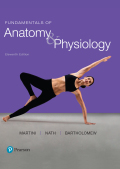
Concept explainers
To determine:
The meaning of the term olfaction
Introduction:
Olfaction or the sense to smell is the ability to differentiate between different types of smells. It is one of the primitive senses in organisms that helps them in detecting the pheromones to catch a prey or mate.
Explanation of Solution
Explanation:
The ability of smell is achieved by olfactory organs that are a part of the nasal cavity. The nasal cavity is lined with the olfactory sensory neurons that aids in detecting the fragrance from the airborne particles. As the air enters the nasal cavity, the particles also enter the cavity along with the air. The swirling action of air brings the water and fat soluble odorants in contact with the sensors.
The signals are transmitted to the olfactory cortex where the signals are decoded by it. The olfactory organs have two main layers namely the olfactory epithelium and lamina propria.
The olfactory epithelium has sensory neurons and the lamina propria is innervated by blood vessels and nerves. It also contains olfactory glands that produce mucous
Want to see more full solutions like this?
Chapter 17 Solutions
Fundamentals of Anatomy & Physiology (11th Edition)
- 4. (6 pts) Use the molecule below to answer these questions and identify the side chains and ends. Please use tidy boxes to indicate parts and write the letter labels within that box. a. How many monomer subunits are shown? b. Box a Polar but non-ionizable side chain and label P c. Box a Basic Polar side chain and label BP d. Box the carboxyl group at the end of the polypeptide and label with letter C (C-terminus) H H OHHO H H 0 HHO H-N-CC-N-C-C N-C-C-N-GC-OH I H-C-H CH2 CH2 CH2 H3C-C+H CH2 CH2 OH CH CH₂ C=O OH CH2 NH2arrow_forwardplease answer (A,B,C,D,E) questions with the asnwer choice provided below. thank you!arrow_forwardplease fill out empty spots. thank youarrow_forward
- There is a species of eagle, which lives in a tropical forest in Brazil. The alula pattern of its wings is determined by a single autosomal gene with four alleles that exhibit an unknown hierarchy of dominance. Genetic testing shows that individuals 1-1, 11-4, 11-7, III-1, and III-4 are each homozygous. How many possible genotypes among checkered eagles in the population?arrow_forwardwhat is this called?arrow_forwardcan you help me identify this it's based on onion rootarrow_forward
- Which evidence-based stress management techniques are most effective in reducing chronic stress and supporting college students’ academic success?arrow_forwardstudents in a science class investiged the conditions under which corn seeds would germinate most successfully. BAsed on the results which of these factors appears most important for successful corn seed germination.arrow_forwardI want to write the given physician orders in the kardex formarrow_forward
 Human Physiology: From Cells to Systems (MindTap ...BiologyISBN:9781285866932Author:Lauralee SherwoodPublisher:Cengage Learning
Human Physiology: From Cells to Systems (MindTap ...BiologyISBN:9781285866932Author:Lauralee SherwoodPublisher:Cengage Learning Principles Of Radiographic Imaging: An Art And A ...Health & NutritionISBN:9781337711067Author:Richard R. Carlton, Arlene M. Adler, Vesna BalacPublisher:Cengage Learning
Principles Of Radiographic Imaging: An Art And A ...Health & NutritionISBN:9781337711067Author:Richard R. Carlton, Arlene M. Adler, Vesna BalacPublisher:Cengage Learning
 Human Biology (MindTap Course List)BiologyISBN:9781305112100Author:Cecie Starr, Beverly McMillanPublisher:Cengage Learning
Human Biology (MindTap Course List)BiologyISBN:9781305112100Author:Cecie Starr, Beverly McMillanPublisher:Cengage Learning





